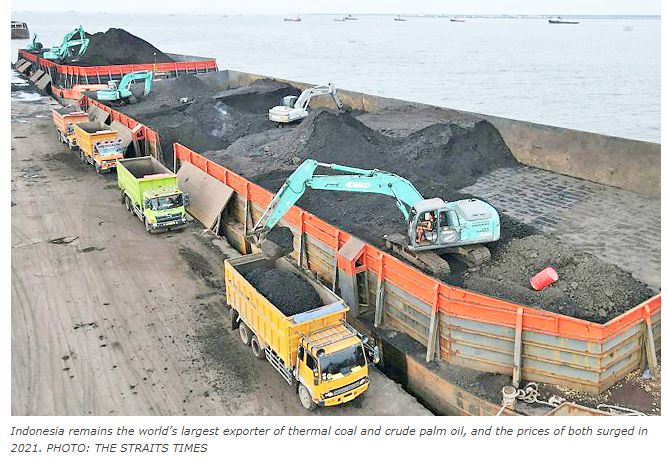Indonesian economy set for strong growth as commodity prices surge
THE STRAITS TIMES – Bolstered by the commodities boom, Indonesia’s economy appears set for a rapid growth rebound in 2022 as a significant decline in COVID-19 cases and deaths prompts easing of social restrictions and the reopening of borders.
The country remains the world’s largest exporter of thermal coal and crude palm oil, and the prices of both surged in 2021. It is also the world’s second-largest rubber exporter. Rich in natural resources, Indonesia also surprised observers with about USD20 billion worth of iron and steel exports, roughly matching the amount for palm oil.
“We are optimistic we will grow five per cent this year. If everything runs smoother, (the economic growth) could be more than five per cent,” Coordinating Minister for Maritime and Investment Affairs Luhut Pandjaitan, a close aide to President Joko Widodo, told The Straits Times on Wednesday.
The World Bank’s latest Global Economic Prospects report released on Tuesday forecast that Indonesia’s growth was expected to rebound to 5.2 per cent in 2022, supported by stronger domestic demand and elevated commodity prices. Growth was expected to reach 5.1 per cent in 2023, the bank said.
But the bank also cited several downside risks for developing countries in the region, including renewed outbreaks of COVID-19, mobility restrictions in the context of pandemic resurgence, incomplete vaccinations and inadequate testing, especially in the face of the highly transmissible but less severe Omicron variant. It also warned of financial risks in the light of rising indebtedness.
Indonesian statistics agency BPS will release its economic figures for 2021 only in early February.
The number of COVID-19 infections, as well as deaths, in Indonesia has relatively flattened.
The seven-day average for infections peaked in mid-July with 50,000 cases daily. The number plunged to 1,700 in early October, and then to 300 at year end, but rebounded to reach about 650 on Friday, due to the spread of the Omicron variant.
Death rates have similarly dropped from the seven-day average peak of 1,700 daily in early August to around 100 in early October, and just six on Friday.
Investment bank Mandiri Sekuritas economists Leo Putera Rinaldy and Imanuel Reinaldo, in a January 9 note to investors, said that Indonesia’s economic growth would hit pre-pandemic levels in 2022. They also forecast a rebound to 5.2 per cent.
“The gear will shift from public-led growth to private-led growth, with consumption as one of the drivers,” the two economists said. “Middle-upper-income and commodity earners will dominate consumption activities in the second half (July to December), while consumption by the low-income group will lag due to the uneven labour market recovery.”
In 2021, the price of coal jumped by about 110 per cent, crude palm oil by 32 per cent and nickel ore by 25 per cent, according to data gathered by Indonesia’s Finance Ministry.
Luhut noted that Indonesia has benefited multiple-fold from these commodity price increases as it has climbed up the value chain by gradually starting to ban the export of raw minerals in an effort to add to state revenue. Beginning in early 2020, nickel ore – the raw material to make iron steel – must be processed domestically before being shipped overseas. The country will ban the export of other minerals such as bauxite – used to make aluminium – in 2022.
Indonesia has about a quarter of the world’s reserves of nickel ore, an essential material for making the batteries for electric vehicles.
“We should not only talk about commodities’ prices but also the added values (generated from processing these commodities),” said Luhut, who was credited with turning a sleepy Central Sulawesi town called Morowali into the world’s largest nickel industrial park.
A similar nickel industrial estate has been built in Weda Bay, in North Maluku province.
“We expect between USD35 billion and USD40 billion worth of exports a year just from Morowali and Weda Bay in 2024,” Luhut said.
A decade ago, Central Sulawesi booked only less than USD1 billion worth of exports annually, mainly from unprocessed nickel ore.


 English
English




